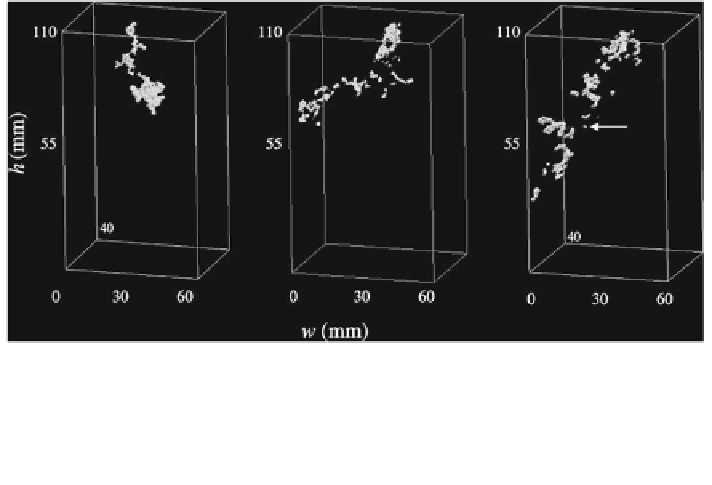Geoscience Reference
In-Depth Information
Fig. 11.4 Pore-scale, three-dimensional images of nonwetting fluid invading a wetting fluid,
under different conditions of capillary and buoyancy-driven forces and for a similar injected
volume. The invasion behavior is characterized by a wide range of displacement patterns and
fragmented clusters, one of which is indicated by an arrow. (Ovdat and Berkowitz
2006
)
Reproduced by permission of American Geophysical Union. Ovdat H, Berkowitz B (
2006
)
et al. (
1988
) to define a Ca-M phase diagram that specifies regions in which stable
and unstable displacements occur. At high M and low Ca, capillary-driven fin-
gering occurs, whereas at low M and high Ca, viscous fingering dominates. Ewing
and Berkowitz (
1998
) extended this phase diagram to three dimensions to account
for buoyancy-gravity forces.
We note also that invasion percolation (IP) models (Wilkinson and Willemsen
1983
; Furuberg et al.
1988
) have been used extensively to simulate the slow
displacement of a wetting fluid by a nonwetting fluid in porous media, when
capillary forces dominate over viscous forces. In such models, the fluid-fluid
displacement process is represented by a cluster growth process on a lattice that at
breakthrough generates a self-similar fractal. The IP algorithm generates structures
that quantitative analysis reveals to be similar to patterns formed during fluid-fluid
displacement processes. While the IP model originally was developed for neutrally
buoyant systems, accounting for capillary forces, it has since been modified to
include the effects of buoyancy on the drainage process (Wilkinson
1984
,
1986
).
Lenormand and Zarcone (
1985
) measured directly the structure of injected clusters
in transparent resin used as porous media.
Finally, it should be noted that NAPL infiltration is accompanied by dissolution
of some components into the aqueous phase, volatilization of other components
into the air phase of the partially saturated zone, and possibly organic complex-
ation with resident soil (Jury and Fluhler
1992
). Mass flux of volatilized phases in
the near surface can be included in transport equations, as discussed in
Sect.11.3
.

